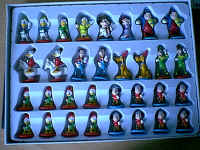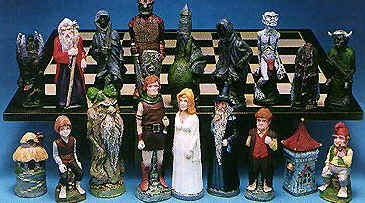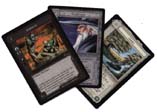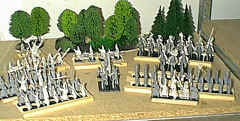Collectable Games
There are two ways you can look at 'collectable' games:
- Collecting as many (valuable) games of one single type (e.g. collecting
monopoly boards, chess boards, etc.), e.g. a Disney, a Tolkien and Ancien Greek
chess set



or
Collecting as part of the game, where as you can / must buy additional
(sealed) boosters to enhance the game. As such you can also identify two
types here, the games with loads of stuff (e.g. Warhammer) or games where the
items are sold blind (not knowing what you exactly buy).
For this chapter I will only discuss the second type (2) of collectable games,
and more specific the 'blind' ones. But first some introduction.
Collectable games came up in the 80's. In general these games cames
come with lots of things. Collectable games had 'collecting' as part of the
fun, you could buy the different parts in (usually dedicated) shops. Games
Workshop was one of those companies that set of a complete industry to these
kind of collectables. One note here: none of the characters you bought were
'blind', you were/are able to select what to buy
In the 90's Collectable Cards Games were introduced, where the cards were
sold 'blind'. As such you had buy a awfull lot of boosters or trade cards in
order to get the cards you really wanted / needed. Magic the Gathering (MtG) of
Wizards of the Coast (WotC) was the first VERY successfull game in this
genre.
In general, collectable games are usually war/fighting games. NLB by WotC is only interesting non-wargame I can thing of (Baseball
game)). Bloodbowl is a typical miniature sportsgame example (american football
alike with load of bashing). In addition, most of the games (espcially the
card games of course) are very 'transportable'. You can easily take
your 'army' with you to go to your friends / club / whatever (this might not
complete hold for Warhammer (40K) or any other miniature wargame, but for most of the games it
does).
As a matter of fact, this collectable part of the game also narrows the target group:
you really need to be in it to play this game (yes, I'm an idiot, I own so many
Bloodbowl teams, magic the gathering cards, diskwar disk, etc. that no friend of mine needs to
buy his own stuff).
Later on came various variations. Most populair these days are miniature
collection games (Mageknight, Starwars Miniatures games (from guess who...
Wizards of the Coast) and others.
tradable card games / collectable card games
(tcg / ccg)
Somewhere in the nineties these first 'true' collectable games came up: the
cards were sold blind,
so you did not know what you were buying. You buy a blind booster and hope
that in there you find this thing you need. Of course trading is part of the
fun. (Actually, selling them is even more fun (see Ebay)). In addition some cards were common,
some uncommon, some rare and some extreme rare. The most succesfull game, actually the one that started this type of
game, is/was 'Magic The Gathering', a collectable card game (CCG) or tradable card
game (TCG).

[some of my more 'expensive' cards]
The idea (at least the official explanation) for this game was to
create thousands of different cards so that no player was able to get all the
cards. And this game has been a hit since its fist introduction up until
now. Some really rare cards are sold on Ebay for $400 or more. There are
always idiots that try to collect all the cards.
 So far several game-types borrowed from
the basic 'magic the gathering' idea. Some games are original in theme, others are spinn off's from
Starwars, Star Trek, Pokemon, Simcity, Lara Croft, X-men, Baseball, etc. Most of these games
however come from the Tolkien theme or furutistic themes. WotC (taken over by Hasbro) is
marketleader in these types of games (check my special
inventory section on the various collectable
cardgames I have). Most CCG's are really bad or broken. The only three
worthwhile to mention are Magic, Middle Earth and Dune (complex!) and then, a
few are really stupid but also very funny. If you want
to get into these types of games I recommend Magic the Gathering.
So far several game-types borrowed from
the basic 'magic the gathering' idea. Some games are original in theme, others are spinn off's from
Starwars, Star Trek, Pokemon, Simcity, Lara Croft, X-men, Baseball, etc. Most of these games
however come from the Tolkien theme or furutistic themes. WotC (taken over by Hasbro) is
marketleader in these types of games (check my special
inventory section on the various collectable
cardgames I have). Most CCG's are really bad or broken. The only three
worthwhile to mention are Magic, Middle Earth and Dune (complex!) and then, a
few are really stupid but also very funny. If you want
to get into these types of games I recommend Magic the Gathering.
There is no need to discuss all the CCG, they are based on what i call the 'MTG'
standard: you need some cards to have power and some cards to 'cast' creatures,
along with some circumstance cards (called 'enchantments', 'event', 'spell',
whatever)
collectable miniatures games
 I
guess, a few of the first games that actually became collectable, in a sense
that you could buy what you wanted, were the Games Workshop games like Warhammer (a
table top wargame) and the alike, actually the miniatures that were sold for use
with this game.
I
guess, a few of the first games that actually became collectable, in a sense
that you could buy what you wanted, were the Games Workshop games like Warhammer (a
table top wargame) and the alike, actually the miniatures that were sold for use
with this game.
Most important: most of the miniatures are not sold 'blind', but there are so
many different ones
that, unless you are a millionaire, you can't affort to have all the armies. As GW started to produce games with miniatures (Talisman, etc.) they took
over Citadel Miniatures and by now they focus completely on miniature games.
Some of these miniatures are highly sought or are extreme ($100+) expensive.
I actually came across a few people that only collect the
miniatures without actually playing the game. And yes, some armies look pretty
impressive as some of these miniatures are pretty detailed and very well painted.
It should be noted that many of the miniature games are more like a hobby
game. Many players (hobbyist) paint the models and take time to build up a nice
scenery.
It
should be mentioned that there are many other table top wargames next to the
GW-games that come with miniatures. High priced miniatures are not uncommon, as some miniatures become OOP (out of print)
or very well painted. I
mentioned Warhammer as one of the first, actually it was not one of the first,
but one of the first COMMERCIALLY sold games, that focussed on miniatures
as main part of the game. Btw, there are many other miniature manufacturers (Ral
Partha is just another one to mention). See
the Wargaming4U site
Check the links on the left site to get to the 'mageknight' collectable game.
After Mageknight, some other companies gain the hang of this type of game. WotC
published a 'blind' miniature game based on StarWars (very playable though) and
more games are to follow propably.
collectable dice games
Collectable dices are sold in starter packs and in booster
packs. Some of the games come with a game board, some of them are played with
just the dices. After you acquired some (blind) starters / boosters, you can put
together your 'army' of dices, where as the individual dices give added value to
eachother. There is actually a newsgroup to dice games (rec.games.dice).
There are just a few cdg's, all started by "dragondice". I counted
5 (see the link on the left). In general, i'm not impressed by these games, but
there are a lot fans though.
others
In general, all games with different characters can be made collectable. It's
that easy. The hard part is convincing your customers that they should buy it.
Typical examples are stratego legends, diskwars, etc. (see the link on the left
side).
Conclusions
Maybe (certainly) there are many more games that have collectable aspects, but
in general one can identify a few critical succesfactors: